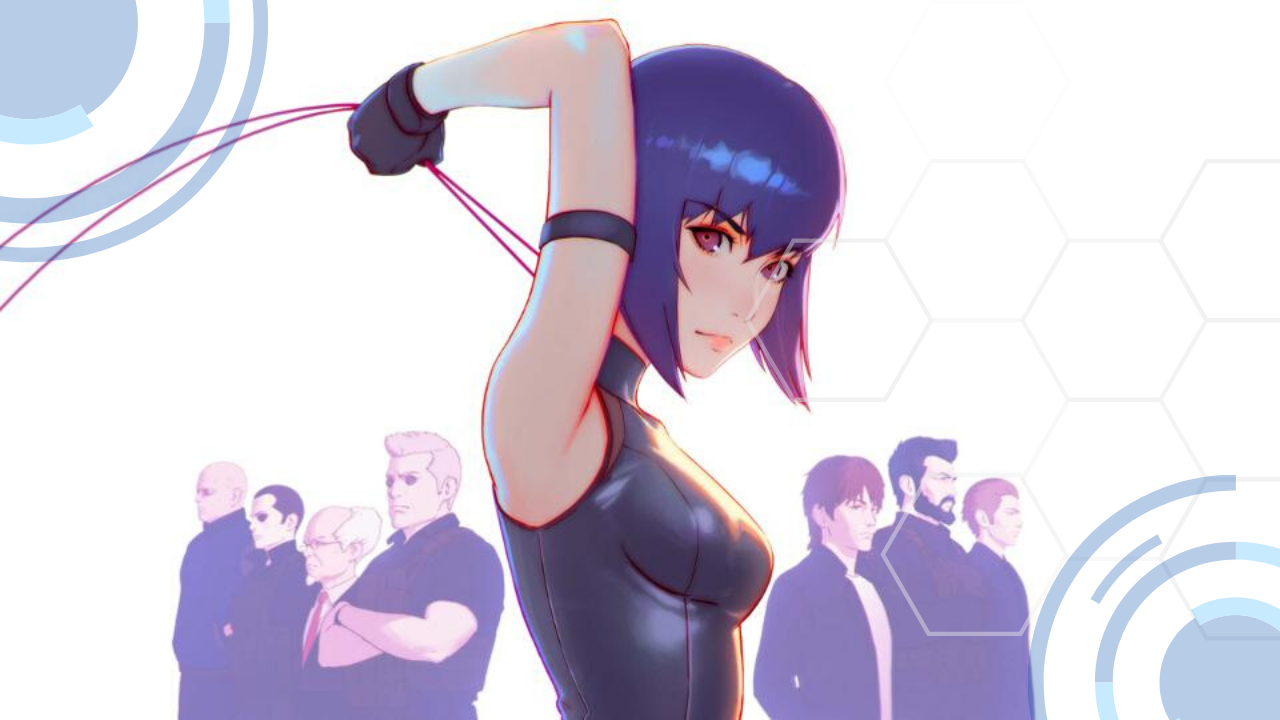Ghost in the Shell: SAC_2045 is the latest re-imagining of Masamune Shirow’s classic cyberpunk manga and, as you might expect from a series that is still going after 30 years, there’s been a variety of interpretations on the material over the years. So what can we expect of the new series based upon what’s gone before? Who’s continuity is it anyway?

In the world of the original Ghost in the Shell Manga, set in a future Japan, humans have been hugely augmented by cybernetic technology. Most people boast cybernetic limbs and enhanced “cyberbrains” which provide better interfaces for humans to communicate with machines and each other. There are drawbacks however. “Cyberbrains” can be hacked and fooled into experiencing things that aren’t real and if a “cyberbrain’s” barriers are breached its “ghost” can be compromised changing who that person believes themselves to be.
Along with “cyberbrains” there are plenty of other physical enhancements available. Major Motoko Kusanagi, the primary protagonist in the series, lives in a fully cyborg “shell” since an accident as a child. The whispering of her “ghost” the only reminder that she’s human.
The Major is a member of Public Security Section 9, a clandestine government paramilitary police force that investigates, and subdues, cybercrime related threats to Japanese National Security, both from without and within, in the real and virtual, typically with EXTREME BLOODY PREJUDICE.
Most of the cases in the original 11 issue series involve the hacking of people’s “cyberbrains” to force them to carry out some criminal act, usually in service to some byzantine political plot (I got lost so many times). The Major and her colleagues deal with these through “diving”, tracing back people’s hacked “cyberbrains”, snooping using their “therm-optic” or active camouflage which renders the user almost invisible. and deploying their cool “Fuchikoma” A.I. spider-tanks alongside their incredibly powerful and resilient military-spec cyberborg bodies. The Major’s svelte appearance belying the incredible strength and resilience at her disposal. In a neat detail, the primary way to identify a combat cyborg is by their weight, as they are so heavy. Many even fear swimming as they usually lack natural buoyancy.
Rereading the series, it’s amazing how well Shirow established his world and the members of Public Security Section 9, from both a design and personality perspective.
From the irascible Section 9 head Daisuke Aramaki, to the iconic Major Kusanagi, to the jovial ex-ranger Batou. No matter what changes are made over the various iterations of the series, these initial characterisations always shine though. Other characters which regularly crop up to keep an eye out for: ex-cop Togusa who’s almost un-enhanced cybernetically compared to his teammates, the sniper Saito, and support staff Ishikawa.
Those “spider tanks”, here known as “Fuchikomas”, also become mainstays of the series over the years. Spindly A.I. controlled tanks that take the rough shape of a spider with wheels at their feet, they act as transport to the members of Section 9 as well as providing supporting fire and comic relief.
As the series nears the end of its short 11 issue run, Section 9 captures a rogue cyborg body that turns out to be home to an A.I. that has developed sentience: the Puppet Master. As its original creators seek to destroy it to obscure its original purpose, it seeks to merge with Major Kusanagi. It sees in her someone like itself and wants to merge to create something new.
While the cute tanks, therm-optic camouflage, political manoeuvring, black operations, and subterfuge have all become integral to most versions of the concept, the goofy anime stylings and visual gags did seem to get lost along the way.

Taking place four years after the events of original manga, Ghost in the Shell 2: Man Machine Interface sees series creator Masamune Shirow himself lead the charge in radically altering his creation.
Apart from appearances by Batou and director Armaki in a framing device, the series feels almost totally separate to the original. Focusing on Motoko Aramaki, an apparent off-shoot of the Kusanagi/Puppet Master personality, she defends Poseidon city with her A.I. agents from an apparent cyber-threat while the rest of Section 9 and the Fuchikoma’s are no where to be seen.
With so few recognisable elements from the original, Man Machine Interface feels more like an opportunity for Shirow to indulge his desires to experiment with 3DCG backgrounds and in drawing the female form. Most of the series takes place in cyberspace, with an idealised form of Motoko, twisting and contorting her nearly naked cyberspace avatar as she carries out numerous cyber battles, some of which go on for entire issues. It’s a direction the creator seems to chide himself for in a side note, as he acknowledges that he may have been “drawing just a little too much exposed flesh here”.
In a foreword supplied with the U.S. collection of the manga, Shirow also stated that “this story is quite different from what was originally called Ghost in the Shell and featured Public Security’s Section 9 (the Special Assault Force) … To those readers expecting a direct continuation of the prior storyline, I apologize and beg for your understanding. I’m sorry, folks!”.
Apart from the cylindrical styling of the cyberspace interface elements and the names of Motoko’s A.I. agents, not many elements from the first official sequel in the series turn up again elsewhere.

In 1995 director Mamoru Oshii ditched the Fuchikoma’s and much of the humour, and added heapings of style, existential angst, and a unique haunting soundtrack by Kenji Kawai, to create an immensely influential animated adaptation of the Manga. From this point onward, music would play a pivotal part in future iterations of the concept.
Retelling the Puppet Master story-line in a stylish and dark future city, the film, along with the likes of Akira, had a huge part in popularising anime as “grown up entertainment”.
Oshii lifted some sequences – like the chase of a cyberbrain-hacked refuse collector with a hacked ghost who is unknowingly acting as a conduit for the antagonist – straight from the manga, expanding it out to a thrilling chase through a futuristic Hong Kong styled city. He also added action elements of his own, like the stylish opening sequence showing the manufacture of a full cyborg body, and the climax, where the Major takes on an incredibly powerful walking tank with her bare (cybernetic) hands. She ends up tearing her (cybernetic) body apart with the stresses of trying to physically pry the tank open.
The film made iconic the image of the Major, looking directly at the viewer, falling from a skyscraper as her active camo comes online, rendering her nearly invisible. It’s an image the franchise returns to again and again, including the recent Ghost in the Shell: The New Movie and the live action movie from 2017.
So influential was this movie that when the Wachowski’s were first pitching the Matrix, according to producer Joel silver, “they showed me what they wanted to do with that type of action and photography and try to make it with real people.” You can see even more obvious “homages” to Ghost in the Shell in The Matrix in this scene by scene analysis. (https://jamesskemp.github.io/gits-matrix/).
In the end the Puppet Master/Kusanagi personality is left pondeing what next, a question that Oshii, like Shirow before him, would struggle to answer.

Seeing as the both the animated film and manga had essentially scuppered even Shirow’s attempts at producing enthralling sequels, for the 2002 anime adaptation, Production I.G. decided to jettison some of the angst and the consequences of the Puppet Master story-line to produce an anime that was a combination of action, intrigue, and a cyber-political thriller. Like the manga, Ghost in the Shell: Stand Alone Complex focuses on the exploits of Major Kusanagi and her Section 9 colleagues, fleshing out her working relationships with Chief Aramaki, her past, and her friendship with Batou and the rest of Section 9.
Over 2 seasons and 26 episodes, SAC took the series back to it’s roots as a (cyber) police procedural, albeit one with frequent mechs and cyborg battles, “cyberbrain” hacking and contemplations of the self, with one of the best opening credits songs of all time.
The first season focuses on the investigation into The Laughing Man, a hacker who can edit his appearance out of people’s very memories while they are looking at him, replacing them with his striking logo. The investigation inevitably leads to the very highest corridors of power and Section 9 has to undertake extreme measures to bring the guilty to justice.

The second season (or as it was known S.A.C. 2nd GIG) focused on Section 9’s investigation into a terrorist group initially fighting for masses of refugees, a member of which, named Kuze, may have close links The Major’s past.
SAC took the stylish mood of Oshii’s movie, married it with the pacing of a weekly police show, and made some gripping television.
The series also reinstated the team’s A.I. agile spider tanks, now slightly redesigned and known as “Tachikomas”, thanks to copyright issues. The A.I. tanks finally got their chance to shine with childlike voices to match their demeanour, as well as heavy weapons. They even got their own short mini skits at the end of each episode. Over the episodes, the Tachikoma’s A.I.’s developed, as their experiences are synced with each other at the end of each day, and play a pivotal part in the climax to Season 2. Their friendship with Batou, and the Major’s suspicious trust of them, make them a key component for future adaptations.
In 2006 a SAC movie was released, Solid State Society, following the Major’s return to Section 9 after leaving at the end of the series. Once again a variation on the Puppet Master story-line was played out, although this time he was known as the Puppeteer.
While Kusanagi rejoined Section 9 properly at the end of the movie, a prequel series, Ghost in the Shell: Arise was produced in 2013, with it’s own movie, the crazily titled Ghost in the Shell: The New Movie, released in 2015. This series featured the early days of Section 9 as The Major slowly recruits the team while investigating a set of cyber-crimes.
Arise also features a red, passenger compartment-less “Logikoma” as a precursor to the “Tachikomas” of SAC.

In 2004 Mamoro Oshii returned to the GITS universe with Ghost in the Shell 2: Innocence, a direct sequel to his 1995 film. Unfortunately, a lot had changed in the 10 years since the original, and the murky, dour atmosphere of Innocence, along with an awkward mix of 3DCG and turgid pacing made it a less than enjoyable watch.
The movie concentrated on Batou and Togusa’s investigation of the apparent malfunctioning of a number of gynoids (sex robots) who killed their owners/clients. During the course of their investigation, as they are helped at various times by The Major in different shells, they discover that someone has been “ghost dubbing” children, copying their ghosts/souls into the robots, to make them more lifelike, at the eventual expense of the children’s own ghost.
Even for Ghost in the Shell this was grim viewing.

The best thing that can be said about Rupert Sanders’ live action adaptation starring Scarlett Johansson, is that I personally had a blast watching Malaysian actor Pete Teo get his sweaty ass handed to him by Johansson in the film, while he was sitting right beside me in a press screening. For everyone else, the film just presented an empty shell.
The film faithfully replicated some of the visual elements from the 1995 anime, Innocence, and SAC but barely dipped a toe into the shallow end of the franchise’s pool of philosophical and political themes. The refuse collector chase from the ’95 movie and manga are replicated almost perfectly. As is the spider tank battle from the end of the ’95 movie. Sanders added a hackneyed plot that took Kuze from the second season of GITS:SAC and dumbed it down for American audiences, making The Major the first of her kind instead of just another (highly advanced) soldier.
In an incredibly ill advised decision, considering the complaints of white washing made against Johansson’s casting, the filmmakers made Johansson’s version of The Major be an Asian woman whose cyberbrain had been placed in a cyborg body with a Caucasian appearance.
On the plus side Pilou Asbæk was almost perfect as Batou.

And so we come finally to Ghost in the Shell: SAC_2045.
Considering that it’s set 15 years after the original SAC and features Kenji Kamiyama, who directed 51 episodes of SAC, as well as the returning SAC voice cast, it could be assumed that this is a direct sequel to Stand Alone Complex and Solid State Society. Netflix, however, have been coy about starting that outright.
There is at least one classic blue SAC “Tachikoma” in the trailer and it appears that all of Section 9 are present and correct. The slightly cartoony designs by Ilya Kuvshinov and upbeat theme by “Millenium Parade” touted by the trailer, however, don’t quite seem to jive with the sombre tone of SAC. It also seems slightly odd to have Kamiyama directing one season of 12 episodes while Shinji Aramaki (Appleseed) directs the other. This could lead to big changes in the series, but we’ll have to see.
Ghost in the Shell: SAC_2045 is available to stream on Netflix on Thursday, April 23rd, at 3pm Malaysian time.
Ghost in the Shell: SAC_2045
Netflix, Season 1, 12 episodes
Directors: Kenji Kamiyama and Shinji Aramaki
Cast: Atsuko Tanaka, Akio Ohtsuka, Kōichi Yamadera, Yutaka Nakano, Toru Ohkawa, Takashi Onozuka, and Osamu Saka








